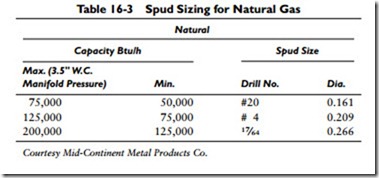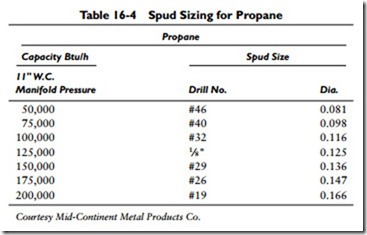Gas Input Setting
The gas conversion burner illustrated in Figure 16-13 is manufactured to operate on natural gas, but kits are available for converting to propane. A very important factor to be considered when installing these burners is a correct determination of the gas input setting, which should be based on the following two factors:
1. The heating rate of the structure
2. The rated maximum input of the burner
The heating rate of a structure is essentially the amount of warm air that the heating unit must deliver to heat it adequately. Methods for calculating the amount of heat required (i.e., the heating rate) are described in Chapter 4, “Sizing Residential Heating and Air Conditioning Systems.”
Another important factor to consider is the rated maximum input of the burner. The gas input cannot exceed this rating. If the burner maximum input of the burner is below the required mini- mum of heat indicated by the heating rate, then the burner is inad- equate for your needs.
The gas input setting for a natural gas conversion burner is regu- lated by the spud (orifice fitting) size and the pressure regulator. A burner is commonly shipped with three different spud sizes, one for each of three capacity ranges (high, intermediate, and low; Table 16-3). The capacity range is changed by using a different spud sizing. After the appropriate spud has been installed, the final gas input setting is made by adjusting the pressure regulator. Be sure to read the burner manufacturer’s installation instructions carefully.
A propane gas conversion burner operates directly on 11-in wg gas supply pressure as determined by the propane-tank regulator. The portion of the combination control on the standard natural gas burner is blanked off with a plate provided in the propane conver- sion kit. Two spuds are provided: a minimum-size main spud and a pilot spud. The main spud must be redrilled for the required capacity (see Table 16-4).

